PAGE 38. Cucciolo History: Rocher & the Elvish
DUCATI CUCCIOLO
The Cucciolo was not only one of the first postwar cyclemotor engines …it was actually one of the first Ducatis: the company started marketing them in 1947, as the T1, which was really a very basic prototype model that had several problems (overheating was the main issue). The T2 was the first production model actually made by Ducati, and the first one that ran well.
*****************
Early 1950s ELVISH Cyclomoteur with 48cc CUCCIOLO 4-stroke engine
**************************************************************************************
CUCCIOLO HISTORY:
The Ducati family founded the Società Radio Brevetti Ducati in Bologna in 1926 and enjoyed a worldwide reputation for radio and electrical equipment. Their factory was destroyed in the 2nd World War, and the Ducati brothers researched new products to introduce when the war ended.
During the War, Aldo Farinelli designed and developed a 4-stroke cycle attachment engine with 2-speed gearing. Ducati joined another Italian company, SIATA, to manufacture this engine as the Cucciolo (“Little Puppy”). It was introduced in 1946 as an auxiliary engine in a box. Ducati now owned the exclusive rights to the Cucciolo.
A new and original design, the T2, was introduced in 1948 and though it was similar to the original it was improved all round. A sports version was added, which could reach a top speed of 60 kmh.
In the first 2 years an average of 240 units a day were produced. In 1948 Ducati designed a new engine, the T3, with 3 gears and a grease-lubricated valve gear enclosed in a case. A new tubular frame with rear suspension was added in 1949. The Sports version introduced in 1950 had a 65cc capacity, swinging-arm, and telescopic shock absorbers.
The 4-stroke Ducati Cucciolo was the market leader in its field, and no other cycle attachment came close in terms of design innovation or performance. Fuel consumption was logged at an amazing 225 a gallon.
This is what the Ducati Museum has to say about it:
“Come with me, I’ll take you on the Cucciolo, the moped is small but the beat of the engine is like my heart.”
1946: With the end of World War II, Italy found itself with little money and a desperate need for transportation – a combination of circumstances that made the introduction of an inexpensive moped just the right invention at the just the right time. The Ducati Cucciolo – advertised with a catchy jingle heard on radios throughout Italy – was a major success that contributed to the advent of mass motoring in Italy.
Designed during the war by two loyal Motociclismo magazine freelancers – lawyer Aldo Farinelli and his brother, engineer Enzo Furio – the Cucciolo, with its two-speed gearbox, was able to carry two passengers and tackle the steep hills so common in Italy. Moreover, being a four-stroke (with overhead valves!) it could cover 100 kilometers with just a liter of petrol without dirtying the spark plugs. Other mopeds, almost all two-strokes, consumed greater amounts of petrol and had spark plugs that frequently needed cleaning.
Six versions of the Cucciolo were manufactured between 1946 and 1958 – each model flaunting significant improvements. According to Bruno Ducati, one of the three founding brothers of the company, almost a million units – a record amount – were made, including those built under license abroad.
The Cucciolo was not simply a popular vehicle for use around town. It also won in tourism and sport competitions, including the 18,000 kilometer Paris-Tokyo ride in 1949 and the world speed records at Monza in 1950. The Cucciolo won on the circuit at Zitelli and many other racetracks in the 50s, including the Six Day International off-road competition in 1951 with Tamarozzi.
Finally, let us not overlook the Cucciolo’s other considerable achievement – that of launching Ducati into the motorcycling firmament.
Carlo Perelli
**************************************************************************************
The ELVISH
With its enviable reputation, manufacturers in various countries bought in the engine to power their mopeds; as it was a top-of-the-range unit, it was reserved for upmarket machines.
This therefore provides an interesting concept – that of a ‘rich person’s moped’ – because these days, of course, we might think of a moped only as a down-market product.
The Elvish is the perfect example of a ‘rich person’s moped.’ Not only is the engine top-of-the-range, but little expense has been spared in the design and manufacture of the machine.
Look at those crazy handlebars!
This is not a cyclomoteur you would expect to see laden with goods in a Paris market, but one to poodle around on your way to the Cannes Film Festival, or something to be parked on your yacht.
Though with its delightfully magical elf-like name, I wouldn’t be surprised to come across one in a wooded glade while out mushrooming in the forest.
I bought this Elvish from Pierre, a friend in France, because it’s one of the prettiest cyclomoteurs I’ve seen.
Also, powered by the Cucciolo 4-stroke engine with such good engineering, it’s a much more practical proposition to use on a regular basis.
He says the engine has never been apart. For good reason, according to him, as he points out how there are numerous diagrams to help you dismantle a Cucciolo engine, but none to illustrate how to re-assemble it.
Pierre sold it because of his divorce. Every Frenchman is a philosopher so maybe we can compare his observation with another activity that’s easy to get into but drives you crazy to get out of: there’s every encouragement to help us fall in love; but nobody ever mentions how to fall out of it again 🙂
**************************************************************************************
Elvish Cycles – 69 Cours Lamarque/ 11 rue François Legallais
The first Elvish shop – pictured above – was located on the corner of de la rue François Legallais et du Cours Lamarque. The manager was G. Hargues.
The Elvish Bicycle company joined the champion cyclist Victor Fontan to create the team ‘Elvish Fontan’ and they took part in the Tour de France in 1928 and 1929. Later the team became Elvish-Fontan-Wolber.
They had racing successes in 1948, 1949 and 1950. Maybe this inspired the creation of the Elvish scooter and cyclemotor prototypes, and the Elvish Cucciolo cyclemotor?
**************************************************************************************
The company ‘Manufacture des Cycles Elvish’ was based at 3 rue de Livron. Pau (B-P). Their first cyclemotor, in 1951, was powered by a VAP 4 engine, and from 1952 also by a 49cc le Poulain. They made cyclemotors until 1957, and the Cucciolo models were produced between 1954-56.
They made a small scooter too, which was also powered by the Cucciolo engine
**************************************************************************************
The M. ROCHER Company
In France, Cucciolo engines were supplied by M. Rocher of Paris, who also made their own cucciolo-powered cyclemotors.
**************************************************************************************
FRENCH DEALERS LICENSED TO SELL MACHINES WITH CUCCIOLO ENGINES
These are the approved dealers in France who were licensed to sell their bicycle or cyclemotor frames ready-supplied with Cucciolo engines from Rocher.
In Paris:
M. Bonney – 133, rue de Rome
Cointot – 89 rue des Poissonniers
Construction Parisienne du Cycle – 139 rue Lafayette
M. Daudon – 27 blvd Rochechouart
Emeriau – 63 rue de Lyon
Fletchner C.N.C – 112 blvd de la Chapelle
Judenne – 25 ave Parmentier
Pitard – 38 rue du Temple
Prefer-Lecomte – 3 rue Myrrha
In the Paris Area:
Bernet – 4 rue Thiers, Choisy-le-Roi (Seine)
Constr. Moderne de Cycles – 130 rue de Bagneux, Montrouge (Seine)
Eriac – 7 ave Peronnet, Puteaux (Seine)
Estampe – 22 rue des Laitieres, Vincennes (Seine)
Faizant / Cycles A.G.F – 4 rue Hoche, Colombes
M. Guitton – 8 rue du Pont-d’-Ivry, Alfortville
M. Zwang – 20 rue Marceau, Ivry-s-Seine (Seine)
In the Provinces:
Alliot – 41 bis, rue du Professuer-Pozzi, Bergerac (Dordogne)
Breton [Baby-Moto] – 11 rue de l’Egalerie, St. Etienne (Loire)
Elvish Fontan – 3 rue de Livron, Pau (B. Pyren) *
M. Fontaine – 63 blvd Voltaire, Rennes (I-et-V)
Foucras et Rochas – 229 ave Jean-Rieux, Toulouse
Gottfried – 23 rue de Rouffach, Mulhouse (Haut-Rhin)
Hugonnier et Routeis – 91 rue Nicolas-Chorrier, Grenoble
M. Kerouedan – Cite Commerciale, ave Clemenceau, Brest
Liberia – 44 rue du Mortillet, Grenoble
M. Pichon [La Randonnette] – 65 rue Aristide-Briand, Chateau-du-Loir (Sarthe)
Cycles Sparting – 21 quai de la Prevalaye, Rennes
Vial – 17 cours Berriot, Grenoble
Villemus – rte de Chambery, Albertville
**************************************************************************************
The Rocher Cucciolo Database
Not many examples of these machines still exist, but I’ll add to this page and create a database of them as I come across models and further information.
To start off, here’s a unique model you probably haven’t come across before. It’s a Zwang, owned by a friend of mine (you’ll see Zwang in the list above)
1950-1954 Zwang Cucciolo
Zwang fitted Cucciolo engines to their frames between 1950 and 1955.
1950 Zwang Sport
1951 Zwang Standard
1954 Zwang Grand Tourisme
1955 Zwang Grand Tours
In 1953, 1954 and 1955 they also made a model with Martinet engine.
**************************************************************************************
1948 Ducati Cucciolo T2 Oscar Egg
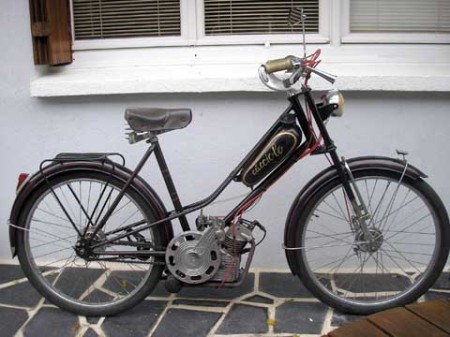
I purchased this rare early Cucciolo in April 2009. The engine and pedal crank bear the Siata-Ducati insignia (close up photos further down the page).
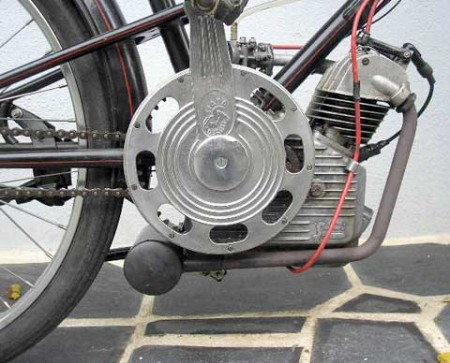
TO SEE MORE OF THE OSCAR EGG CUCCIOLO, PLEASE CLICK HERE
**************************************************************************************
Rocher Carley
**************************************************************************************
ABG
**************************************************************************************
Cucciomo
**************************************************************************************
Cucciolo Engine Illustration & Parts List
**************************************************************************************
DUCATI’s description of the CUCCIOLO T50
CUCCIOLO motorizes your push bike, This little super-efficient 1 1⁄2 HP dual-gear engine will take you anywhere, untiringly, in comfort.
CUCCIOLO is wonderfully light: 8 Kg. (17 1/2 lbs), just the weight of a parcel.
CUCCIOLO engine can be fitted without alteration to any type of Ladies or Gentlemen’s bicycles. Fitting is at the bicycle bottom-bracket. Weight distribution is 55% on front wheel and 45% on back wheel.
CUCCIOLO is the most widely used bicycle engine in the world. Servicing facilities and spare parts are available in every country.
CUCCIOLO is a four-stroke engine: no oil has to be mixed with fuel. Lubrication of engine independent and fully automatic. No mixture being used, refueling is simple and speedy.
CUCCIOLO has chain transmission. The actual chain of the bicycle is used for the drive. This reduces wear on tires to a minimum, avoiding also broken wheel-spokes and twisting of frame.
CUCCIOLO incorporates a two-speed, pre-selection gear-box; the ratio enables to negotiate gradients at speed without the aid of the pedals. Efficient cooling is provided by a number of slots and fins where the airflow is maximum.
CUCCIOLO has a multiple metal-plate clutch working in oil bath: starting and halting are extremely smooth. The engine can be kept-on running while the bicycle is at a stop.
CUCCIOLO has greater power and is cheaper to run than any other two stroke engine of the same cylinder capacity.
CUCCIOLO is simple, strong and reliable. It is the perfect answer to the most exacting requirements.
Engine: Four-stroke, overhead valves Bore: 39 mm. Stroke: 40mm., Cylinder Capacity: 48 c.c. Compression ratio: 6,5. Cast-Iron cylinder. Three-ring aluminum piston, with oil-scraper ring. Cylinder can be inspected without disturbing ignition timing or valve-setting. Light-metal crank-case and sump. Ball and roller bearings
Normal rating of engine. 4.500 r.p.m.: Maximum rating: 5,500 r.p.m. Power 1 1⁄2 HP.
Lubrication: Independent and fully automatic. Crank-case and sump contain 350/400 grams (13 1/2 oz.) of oil.
Ignition: Permanent-magnet four-pole flywheel. rotating at 1/1 ratio with the engine shaft.
Carburetor: Single-control Automatic.
Clutch: Metal friction-plates running in oil bath in crank-case.
Gears: Two speeds and neutral position. Ratio between low ell high gear 1/1,735. Gear pre-selector operated according to position of the bicycle Pedals. Gear change is actuated by a single action on the hard-clutch lever.
Power drive: Single chain from engine to back wheel sprocket. The actual chain of the bicycle is used.
Lighting system: Electric light is supplied by the magnetic fly-wheel. Raring is 6 V at 1 amp-., sufficient for head-lamp and rear-light.
Fuel consumption: About 100 kilometers = 1 liter of petrol, corresponding to about 275 miles per gallon. Oil is used at the rate of about 1/10th oz. per 100 kilometers. Minimum speed: 7 km. (14 1/4 m.p.h.) in high gear, and 4 km. (2 1/4 m.p.h.) in low gear.
Up-hill riding: Gradients up to 18% are negotiable, according to the bicycle back-sprocket ratio. Stepdown reduction between main and power-sprocket is 10,5 to 1.
Fuel-tank capacity: Two liters, corresponding to abort 3 1/2 pint.
Exhaust-pipe: low- pressure silencer.
DUCATI BORGO PANIGALE BOLONGA – DUCATI EXPORT DIVITION MILANO
**************************
CUCCIOLO T50 HANDBOOK




















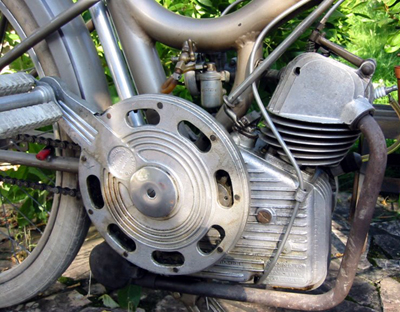
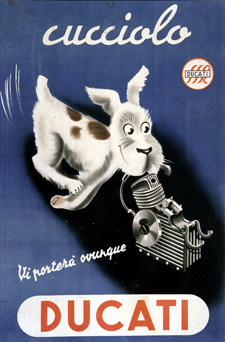
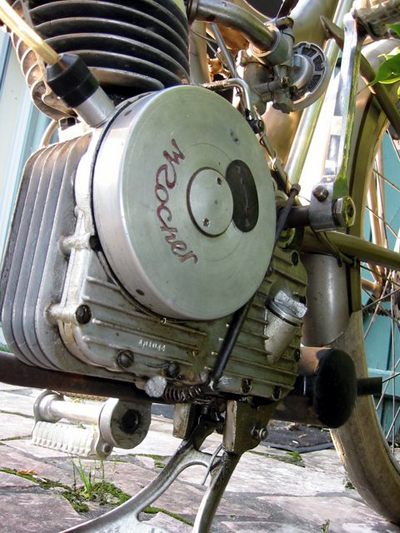

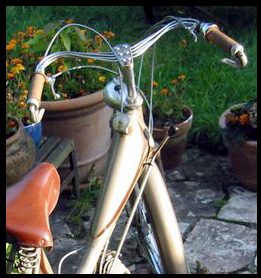
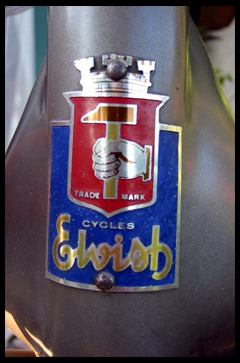



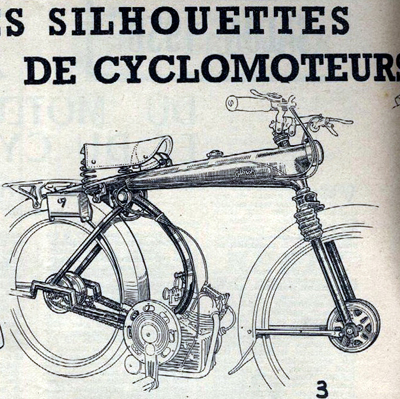
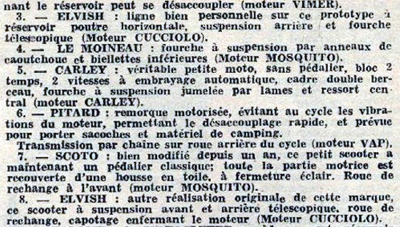
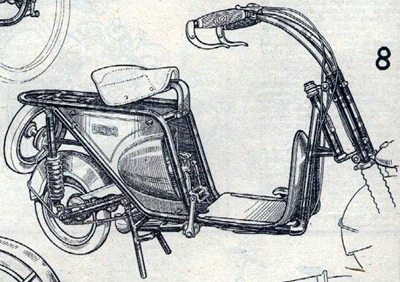
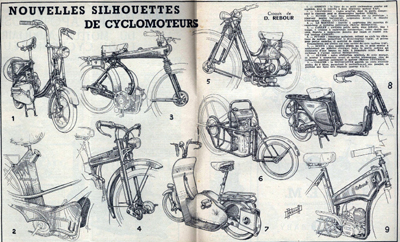

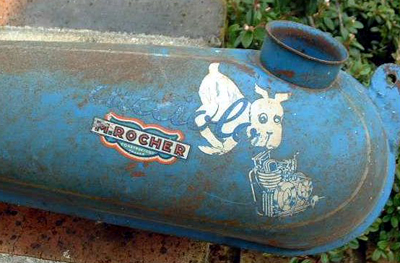
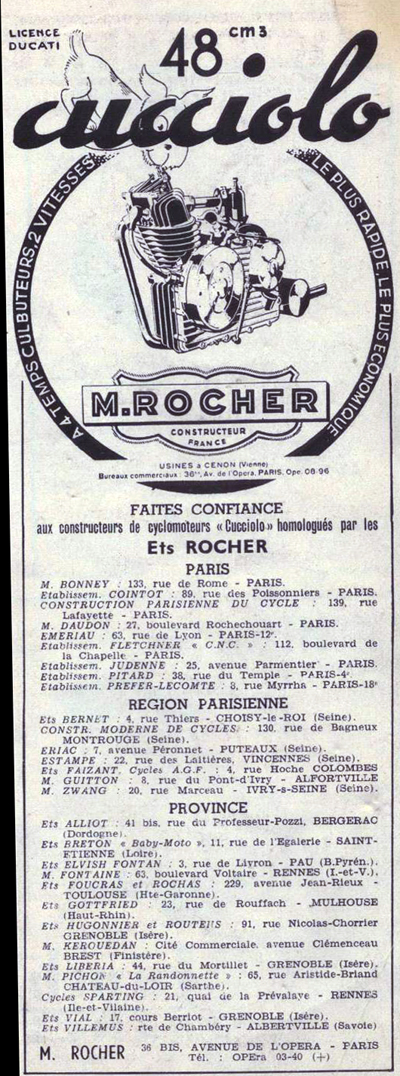


























You must be logged in to post a comment.